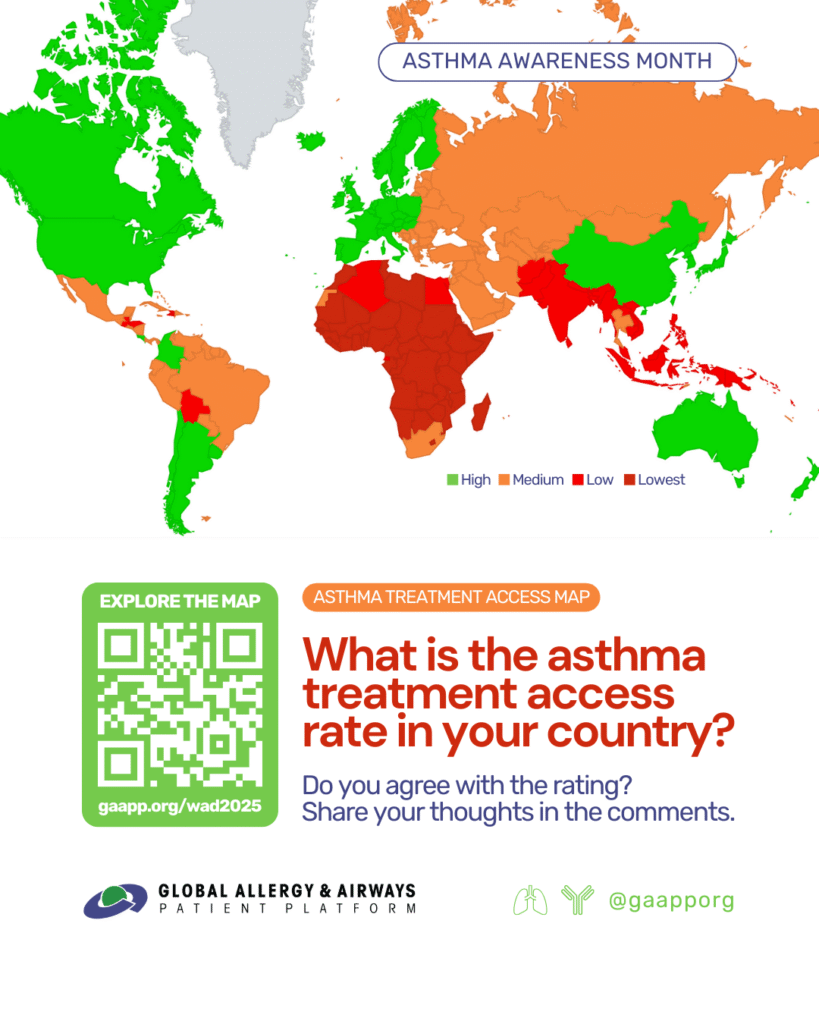Overview
World Asthma Day is an annual event initiated by the Global Initiative for Asthma (GINA) to raise awareness, improve asthma care, and advocate for equitable access to essential treatments. The inaugural World Asthma Day took place in 1998, alongside the first World Asthma Meeting in Barcelona, Spain, with participation from over 35 countries. Since then, involvement has grown steadily each year, making it one of the most significant global events dedicated to asthma awareness and education. World Asthma Day is observed annually on the first Tuesday of May.
Theme 2025
In 2025, the focus is on making inhaled medications accessible to everyone, everywhere, to reduce preventable suffering and deaths, “Make Inhaled Treatments Accessible for ALL“
Key facts
- Asthma is a major noncommunicable disease (NCD) that affects people of all ages, including children and adults, and is the most common chronic condition among children.
- Asthma is characterized by inflammation and narrowing of the small airways in the lungs, leading to symptoms such as coughing, wheezing, shortness of breath, and chest tightness.
- Globally, asthma affected an estimated 262 million people in 2019 and was responsible for approximately 455,000 deaths—most of which are preventable.
- Inhaled medications, especially those containing corticosteroids, are highly effective in controlling asthma symptoms and enabling individuals to live normal, active lives. In addition, avoiding known asthma triggers can significantly reduce the frequency and severity of symptoms.
- Access to essential asthma treatments remains a major challenge. In low- and lower-middle-income countries, under-diagnosis and under-treatment—often due to limited availability and the high cost of inhaled medicines—contribute to 96% of global asthma-related deaths.
- Even in high-income countries, the affordability of these medications continues to be a barrier, leading to poor disease control and preventable fatalities.
- Asthma cannot be cured but there are several treatments available.
- The most common treatment is to use an inhaler, which delivers medication directly to the lungs. Inhalers can help control the disease and enable people with asthma to enjoy a normal, active life.
(Facts: WHO, GINA)
Global asthma care access map
Aligned with GINA’s theme for World Asthma Day, Global Allergy and Airways Patient Platform (GAAPP) has introduced its 2025 campaign titled “Access to Treatment for All.” As part of this effort, GAAPP is launching a global asthma care access map that visually illustrates how different countries are performing in providing asthma care services.

Call for action
- Policy makers, governments, payers, and pharmaceutical industry manufacturers and suppliers are called upon to increase their awareness of the continuing preventable morbidity and mortality associated with asthma in spite of the existence of evidence based, highly effective management of asthma.
- We call on everyone to increase their efforts to “Make Inhaled Treatments Accessible for ALL”, in all countries throughout the world.
Related readings
- World Asthma Day 2023: Asthma Care for All
- World Asthma Day 2022: Closing Gaps in Asthma Care!
- Asthma:Better Air, Better Breathing #WorldAsthmaDay.
- World Asthma Day – Public Health Update
- Asthma Care for All Archives – Public Health Update
- STOP for Asthma: World Asthma Day 2019 – Public Health Update
- World Asthma Day 2018: Never too early, never too late
- World Lung Day 2022: Lung Health for All – Public Health Update
Do you have a website? Looking for the best hosting provider? Here’s a discount code.
Latest Public Health Jobs
Latest Posts
- Political declaration of the fourth high-level meeting of the General Assembly on the prevention and control of NCDs and the promotion of mental health and well-being
- Kathmandu Declaration: Financing for Universal Health Coverage
- The Belém Health Action Plan for the Adaptation of the Health Sector to Climate Change
- Registration Now Open: Delivering for Nutrition in South Asia 2025 – Towards Impact at Scale!
- World Chronic Obstructive Lung Disease (COPD) Day 2025: Short of Breath, Think COPD!
Thanks for visiting us.
Disclaimer: The resources, documents, guidelines, and information on this blog have been collected from various sources and are intended for informational purposes only. Information published on or through this website and affiliated social media channels does not represent the intention, plan, or strategies of an organization that the initiator is associated with in a professional or personal capacity, unless explicitly indicated.
If you have any complaints, information, or suggestions about the content published on Public Health Update, please feel free to contact us at blog.publichealthupdate@gmail.com.
#StayUpdated


